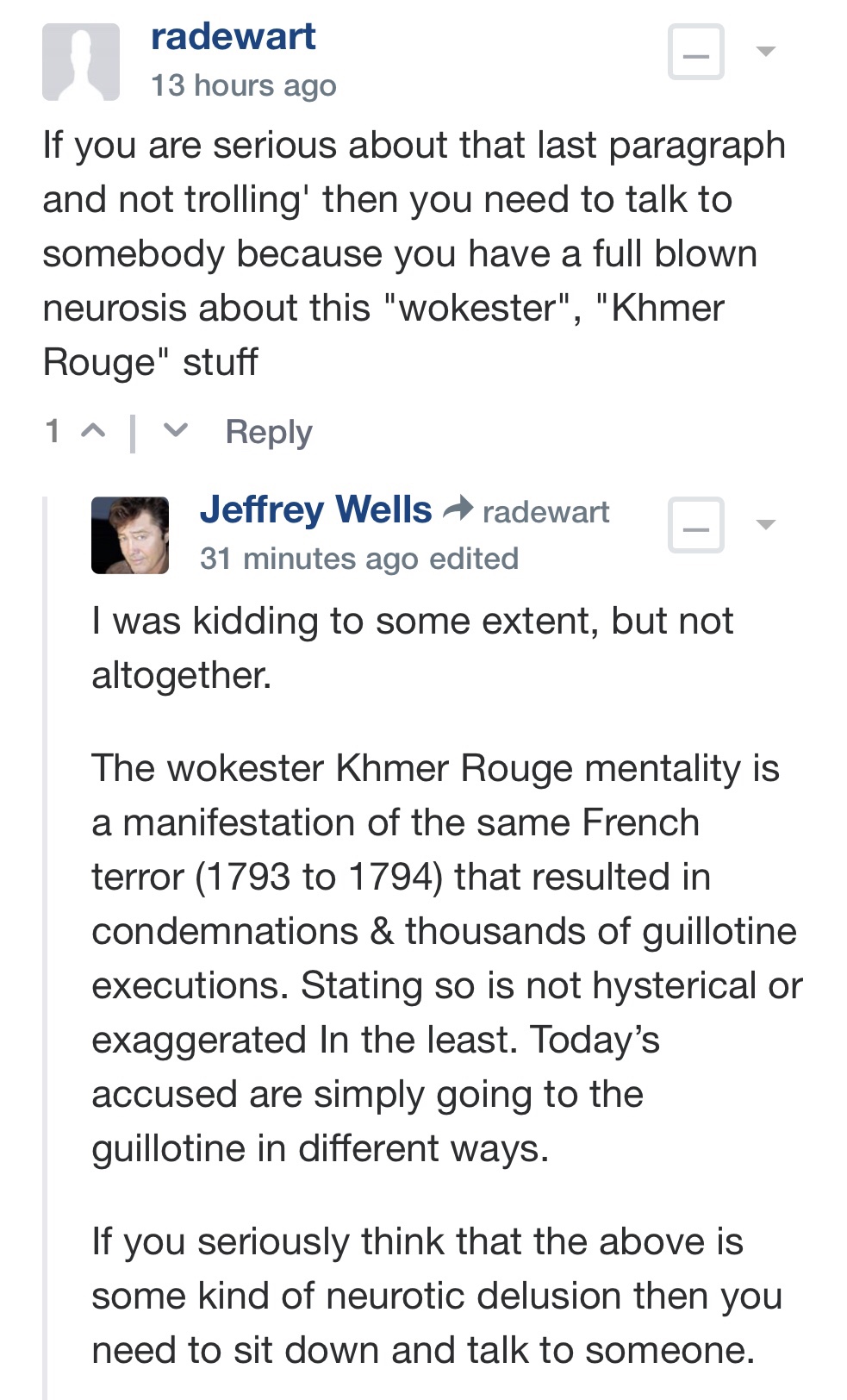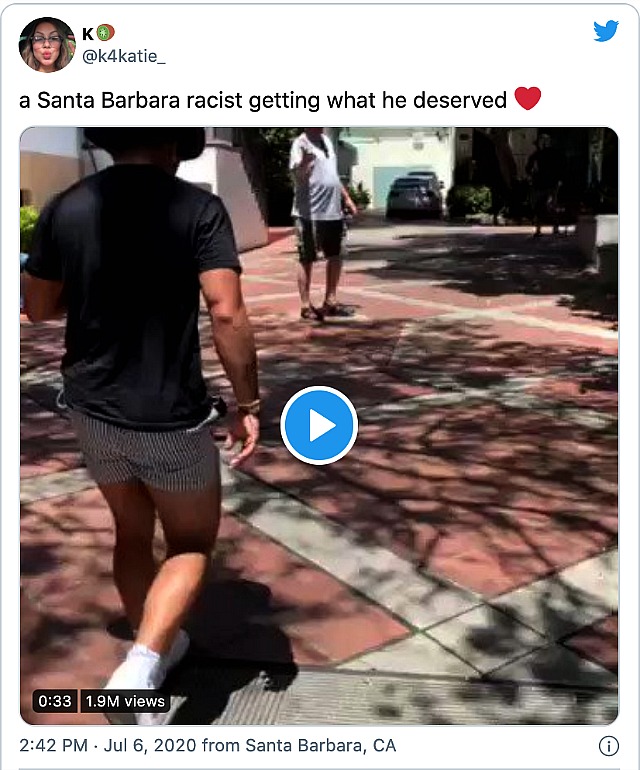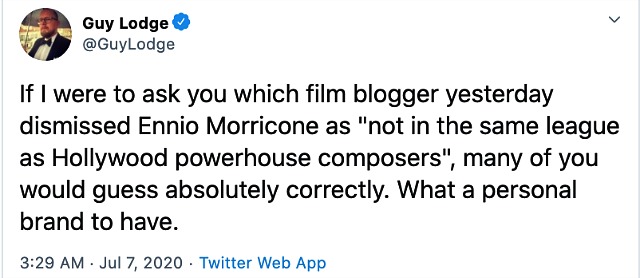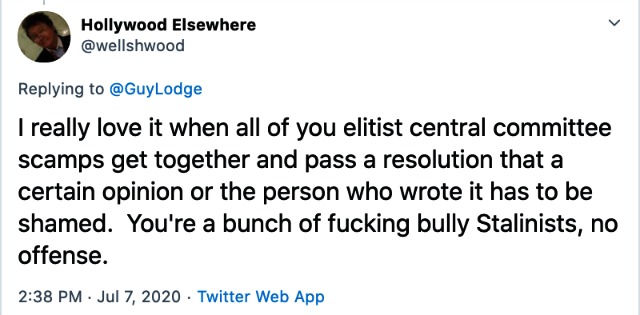
Hard Telluride COVID Numbers
I’m told that a few…okay, more than a few nervous nellies are expressing concern about attending the 2020 Telluride Film Festival, which will kick off eight weeks hence. Visitors will arrive on Wednesday, 9.2, and leave on Monday, 9.7.
The concern is that Los Angelenos, who will constitute most of the visiting throng (along with a significant percentage of New Yorkers), might be risking exposure to COVID-19 — on the plane or in the town, or certainly inside theatres.
And yet the statistical likelihood is that of less than one percent of potential Telluride attendees might be infected…maybe. And most likely fewer than that.
Hollywood Elsewhere’s theory is that the Los Angeles industry folk who would attend Telluride aren’t young, cavalier, incautious, come-what-may, party-animal types, and are mostly the opposite — older, prudent, cautious, mask-wearing, hand-washing types.
So it’s not like “Californians” en masse will be attending but residents of industry-centric Hollywood, West Hollywood, Pacific Palisades, Brentwood, Venice, Santa Monica, Malibu and Manhattan Beach.
I’m not great with math but consider these figures from LA County’s Public Health site:
Of West Hollywood’s 36,384 residents, 300 are infected with COVID-19 — less than 1%. Out of Beverly Hills’ 34,362 residents, just under 1% are infected. Santa Monica has 92,078 residents, and of these 457 are infected — one-half of 1%. Manhattan Beach has 35,773 residents with 169 infected — less than half of 1%. Malibu has 12,846 residents with 57 infected — less than 1/2 of a percentage point. Of Hollywood’s 90,322 residents, 543 are infected — .6% or a tad more than half of 1%. Venice has 111 infected out of 40,885 residents — close to .3%. Of West LA’s 42,797 residents, 238 are infected — 1/2 of 1%. And so on.
Residents of Brentwood’s Mandeville Canyon number 2571, and of these only 4 people are infected.
I’m naturally presuming that the percentage of Los Angelenos travelling to Telluride would be significantly less than 1/2 of one percent, because what kind of idiot who’s been infected would want to attend in the first place? Yeah, I know — asymptomatic carriers might have it without realizing. But we’re still talking about an extremely small micro-percentage.
On top of which Telluride, Colorado, which has a total native population of 2,484, is nearly disease-free. A 6.22.20 Telluride News story reported 12 new infections, and these won’t constitute the reality around Labor Day. The total cases in San Miguel County, which numbers 8,191, was recently 28 “with 12 active cases and 22 recovered,” the story said. That’s .3% of the population.
Spreading “1619 Project” Gospel
Most of us understand “critical race theory“, which holds that white privilege and white supremacy have been long ingrained in American society.
And many of us have read or at least skimmed the N.Y. Times‘ “1619 Project“, which basically says that the history of the United States and the character of its paleface citizens have been defined by racism and white supremacy all along, and that this poison is embedded in our social root structure**, and that whether they realize it or not whitebreads need to submit to intensive anti-racist training to even begin to fix things.
These claims and interpretations have mostly been the concern of cultural elites over the last 15 or 20 years, but now, through the good graces of Oprah Winfrey, the New York Times and Lionsgate, a series of feature films and television shows based on “The 1619 Project” will eventually become a mass-market reality.
There are many academics who’ve disputed the accuracy of “The 1619 Project” (including a group of African American academics who comprise “The 1776 Project“), but I’m going to rely upon New York magazine’s Andrew Sullivan, who posted an argument on 9.3.19.
His piece was mainly about the radical culture of the N.Y. Times. It was titled “How The New York Times Has Abandoned Liberalism for Activism.” Here’s an excerpt:
“The New York Times, by its executive editor’s own admission, is increasingly engaged in a project of reporting everything through the prism of white supremacy and critical race theory, in order to ‘teach’ its readers to think in these crudely reductionist and racial terms.
“That’s why ‘The 1619 Project’ wasn’t called, say, a ‘special issue’ but a ‘project’. It’s as much activism as journalism.
“And that’s the reason I’m dwelling on this a few weeks later. I’m constantly told that critical race theory is secluded on college campuses, and has no impact outside of them — and yet the newspaper of record, in a dizzyingly short space of time, is now captive to it. Its magazine covers the legacy of slavery not with a variety of scholars, or a diversity of views, but with critical race theory, espoused almost exclusively by black writers, as its sole interpretative mechanism.
“Don’t get me wrong. I think that view deserves to be heard. The idea that the core truth of human society is that it is composed of invisible systems of oppression based on race (sex, gender, etc.), and that liberal democracy is merely a mask to conceal this core truth, and that a liberal society must therefore be dismantled in order to secure racial/social justice is a legitimate worldview. (That view that ‘systems’ determine human history and that the individual is a mere cog in those systems is what makes it neo-Marxist and anti-liberal.)
“But I sure don’t think it deserves to be incarnated as the only way to understand our collective history, let alone be presented as the authoritative truth, in a newspaper people rely on for some gesture toward objectivity.
“This is therefore, in its over-reach, ideology masquerading as neutral scholarship.
“The NYT [has chosen] a neo-Marxist rather than liberal path to make a very specific claim: that slavery is not one of many things that describe America’s founding and culture, [but] is the definitive one.
“Greyhound” Does The Job
Tom Hanks‘ Greyhound is a tight, tense, no-bathroom-breaks battleship flick, and altogether a better-than-reasonably-good action film. It’s obvious catnip for war-film aficionados, and certainly for WWII buffs.
Aaron Schneider directed, but Hanks — the star, sole screenwriter and producer with Playtone partner Gary Goetzman — is the ranking auteur here, and you can’t help but admire the meticulous honing that went into upping the suspense-and-danger factor. Once on board and underway, the narrative offers no breathers.
For this is a riveting procedural — a taut logistical drama set on gray, heaving seas, about rookie naval Commander Ernest Krause (Hanks) and the crew of a destroyer escorting a convoy of 37 ships across the North Atlantic in early ’42, and dealing with all kinds of hair-raising hell.
It’s Krause’s maiden voyage, by the way, and he frankly looks a little old to be a greenhorn but we’ll let that slide.
The emotional engagement comes from Hanks trying like hell to play the role of the wise, confident daddy and to not screw up by failing to focus for even a second or two. The pressure is on every waking second.
Along with the cargo-laden convoy, Krause and crew obviously need to dodge German torpedos while inflicting as much damage upon the wolf pack as possible. This is the whole agenda, the whole film. Greyhound is therefore dealing a forced deck — every moment has to be pounding, every piece of information has to impart alarm.
The critical action in this 91-minute suspense thriller actually occupies 80 minutes if you discount the opening and closing credits, and is shorter still if you eliminate a stateside dinner scene between Krause and wife Evelyn (Elizabeth Shue) that adds zip to the overall. And let’s also cut out that praying at bedside stuff. And who cares if Hanks has bleeding feet?
Most of the tension comes from Hanks and key subordinates eyeballing sonar screens and gauging possible threat levels. There’s so much focus on those screens (along with other ominous visual indicators) that I was reminded of the missile-track sequence from Dr. Strangelove. A good portion of Greyhound is, in fact, that Strangelove sequence — “submarine five miles away and getting closer…four miles off…three!”
Last March I complained about the Greyhound trailer looking like “a video-game fantasy” and “a damn CG cartoon”. I even claimed that the film lacked a certain feeling of “tactile reality” that one got from older sound-stage war films like Mark Robson‘s The Bridges at Toko-Ri, Humphrey Bogart‘s Action on the North Atlantic or Cary Grant‘s Destination Tokyo. And yet, despite my loathing of computer effects, I somehow became accustomed to them once the film began, although the waves, explosions and tracer bullets always feel synthetic. I’m sorry but they do.
In summation, Greyhound isn’t half bad and plays better than I expected. A crisp salute to costars Stephen Graham, Manuel Garcia-Rulfo, Karl Glusman and Tom Brittney.
Does Greyhound fall short in failing to pay proper respect to African Americans who fought and died bravely during that historic conflict? Lamentably, yes. If I had been in Hanks or Goetzman’s shoes I would done a Hamilton and inserted a scene or two of an African American admiral keeping tabs on the situation, just to play it safe. Will Hanks and Geotzman be threatened with cancellation for casting Rob Morgan as a white-coat chef who’s constantly preparing eggs, bacon and pancakes for Hanks? Hard to say, but don’t be surprised if wokesters make a thing out of this.
“Outpost” Chickens Are Sorry Now
It would appear that Rod Lurie‘s The Outpost has become, at least to some extent, the new American Sniper — a unanimously well-reviewed war flick that’s connecting with both urban and (perhaps particularly) heartland audiences.
It was reported two days ago that The Outpost is the top renter/seller on iTunes as well as FandangoNow. It still has that standing as of today (7.8). It’s also been reported that the stock price of Chicken Soup for the Soul Entertainment, owner of distributor Screen Media, had surged 26% due to Outpost popularity.
As one of the film’s earliest and most ardent supporters, Hollywood Elsewhere trusts that The Outpost will keep chugging and humming along, and that come award season Caleb Landry Jones‘ performance will continue to generate enthusiasm for a Best Supporting Actor nom.
A fair number of big-time distributors were offered The Outpost earlier this year. Everyone but Screen Media responded with the usual “uhm, we don’t know how to sell it.” Translation: We’ve forgotten how to sell well-crafted war movies on their basic merits, and Scott Eastwood, Orlando Bloom and Caleb Landry Jones aren’t big enough names.” Lurie to prospective distribs: “It’s a straightforward ‘support the troops’ heartland flick with a potential to be the next American Sniper, and it’s relatively inexpensive — how can you not make money with it?”
Screen Media, at least, was willing to take the gamble, and now they’re looking like the smartest kids in the room. All due credit to their foresight, business acumen and marketing (i.e., the little choo-choo engine than showed up the studios).
The original Screen Media plan was to debut The Outpost at South by Southwest and then open it nationwide theatrical run via Fathom, but COVID-19 killed Austin and then the recent surge destroyed the Fathom plan.
In a Deadline guest column, Lurie wrote that his “primary attention and anxieties for this past weekend were directed at how the military community would receive the film, in particular veterans of the Afghanistan War and, even more microscopically, the soldiers and families of the men who served at Combat Outpost Keating where the film is set. That would be the metric of success for this particular film.
“Last October, we showed the movie in rough-cut form to several of the surviving veterans and to family members of the eight men who died in this battle. Jake and I were both nervous wrecks. We had worked so hard on the film and been in constant communication with these people, and yet…well, who knew how they’d react?
“The release of the film prompted an avalanche of support from veterans of the war. Dr. Dan Barkhuff, a Navy SEAL and graduate of the Naval Academy, said it was ‘the best war movie since Black Hawk Down, maybe better.” (Perhaps a bit much, but we’ll take it.)
“A Green Beret with 24 years of service: ‘The authenticity in the film is amazing…it had me reliving the sights and smells of the Nuristan province.’
“On Reddit a veteran observed, ‘The best way to honor these men is to remember them, remember their families when you think of your loved ones, they had wives and children that will never see their husbands/fathers again.’
“A military spouse wrote, ‘If anyone in our country starts to lose respect for what our soldiers go through in a time of divisive politics; they need to see this movie. We owe all of them our deepest gratitude. I can’t thank you enough for putting this together.'”
By Any Fair Measure
a Santa Barbara racist getting what he deserved ❤️ pic.twitter.com/Vf7ewwNR6H
— K🥝 (@k4katie_) July 6, 2020

HE vs. Snooty Morricone Scolds
Futile repeating of basics: The late Ennio Morricone was a legendary film-music composer. The common consensus is that he deserves a place in the pantheon, and I’m certainly not arguing with that. But his score for Terrence Malick‘s Days of Heaven (’78) is the only one I truly love, and I just don’t believe that his stuff was otherwise all that elevating or transcendent. Over a half-century-long career he created good, respectable, at times haunting, occasionally hum-worthy music. And that’s as far as I can go.
Alas, yesterday the People’s Central Committee for the Assessment and Approval of Critical Opinion decided that yesterday’s “Subdued Respect” post had to be condemned. What’s that old Carly Simon line? “These are the good old days.”



Best Lincoln Project Trump Ad Ever?
Manic but well-disciplined editing plus a fascinating paranoid-whisper soundtrack delivers the effect of being inside Donald Trump‘s mind on a bad day. It reminds me of the brilliant editing in Oliver Stone‘s JFK. HE commenter Jeff Tompkins: “Agreed. A brilliant exercise in Psyops using his phobias against him. Biden’s strategy of letting Trump kill himself while hiding some of his own weaknesses would also be brilliant, if it was actually planned.”
Harper’s to Khmer Rouge: Back Off
In a July 7 manifesto titled “A Letter on Justice and Open Debate” and signed by over 100 journalists, authors and academics, Harper’s is warning the world about the dangers of woke fanaticism and Robespierre cancel culture.
“Whatever the arguments around each particular [twitter-shaming or cancelling], the result has been to steadily narrow the boundaries of what can be said without the threat of reprisal,” the essay notes. “We are already paying the price in greater risk aversion among writers, artists, and journalists who fear for their livelihoods if they depart from the consensus, or even lack sufficient zeal in agreement.
“This stifling atmosphere will ultimately harm the most vital causes of our time. The restriction of debate, whether by a repressive government or an intolerant society, invariably hurts those who lack power and makes everyone less capable of democratic participation. The way to defeat bad ideas is by exposure, argument, and persuasion, not by trying to silence or wish them away.”
Kaufman’s Film-Nerd Satire
I’m naturally interested in Charlie Kaufman‘s just-published Antkind. What blogaroo wouldn’t be? I’ve only read the opening chapter, but it appears to be a withering satire of a highly self-regarding film devotee slash journalist-author type. The title, which could be interpreted to mean “kind of like an ant”, seems to indicate Kaufman’s attitude about his middle-aged (late 40s?) protagonist.
He sounds like a cross between Humbert Humbert and a Jewish Gerald McBoingBoing. (It’s actually Rosenberg something-or-other.) He’s bald and proudly wears a big, Herman Melville-ish, Brillo-paddy Richard Brody beard as a badge of honor and exceptionalism. He wears “owlish wire-rim glasses” and has a “hawkish nose and sunken blackbird eyes.” And he has a fetching, significantly younger African American girlfriend with whom he has great sex…bullshit.

To go by the Amazon excerpt, the tone of the book is a kind of deep-burrowing insect absurdism. Or, you know, a kind of surrealist extremism that keeps the reader at arm’s length. Nothing is real, and nothing to get weirded out about because it’s Charlie Kaufman wandering through a hermit-termite world…a low-rentish, film-dweeb nether realm, half cave and half steel cage.
Descriptive excerpt: “Trapped in a self-imposed prison of aspirational victimhood and degeneratively inclusive language…while attempting to keep pace with an ever-fracturing culture of ‘likes’ and arbitrary denunciations that are simultaneously his bête noire and his raison d’être.”
HE commenter Jimmy Porter said this morning that Kaufman “gets effete film bloggers down to a tee.” The toenail-fungus kind, he means. We’ve only just met, but Rosenberg McBoingBoing has never owned a pair of suede Bruno Magli lace-ups, trust me. And he’s certainly no urban rumblehogger.
In the opening chapter Humbert Rosenberg McBoingBoing is driving through pitch-black darkness in rural Florida, heading toward St. Augustine. Every so often he notices a roadside fast-food joint with the lights on but zero customers. One of these operations is called Slammy’s. Any rural fast-food joint with an eccentric, clearly non-corporate name like Slammy’s is something to be savored if not cherished. If I saw an open-for-business Slammy’s in some out-of-the-way hamlet I would pull over without hesitation. I would order and sit on one of the outdoor benches and phone-surf. I would breathe it all in and smell the air and gaze at the stars.
Charlie’s protagonist pulls in, but only to get some paper towels and a cup of water to clean his windshield with. That’s a significant difference right there.
“Writing Happens To You”
New Yorker film editor/columnist Richard Brody, speaking in a video dated 2.1.14: “The act of writing, itself, is almost sexual. The act of writing, itself, is almost transcendent. Nobody should ever be proud of their writing. Because no one should ever take credit for writing. It happens to you.”
Correction: Good writing happens to you. You’re sniffing and digging and poking around, and then, if God or fate or luck wills it, you’ll strike oil in the same way that James Dean‘s Jett Rink noticed oil seeping through the mud. If you stay with it (and if you’ve any kind of knack or talent) you’re suddenly in the groove and maybe even riding a perfect wave.
The best way to find oil is to not care if what you’re tapping out is any good. If you’re reviewing yourself as you write, if you’re overly concerned with how people might react as you’re attempting to say or explain something, you’ll never take flight. Otherwise writing…typing, I should say, is drudgery. Typing without hope of oil is worse than digging ditches.
And being stuck on a dry, oil-less plateau with an IBM Selectric while sitting inside a West Fourth Street studio back in the early ’80s…it was so godawful I can’t revisit.
Out Of The Blue
Phillip Noyce‘s Above Suspicion, a brilliant Kentucky redneck crime drama that I first saw and wrote about three years ago, is still unreleased. It was going to open last March but you know what happened. The last I heard the U.S. debut would be in early ’21. The 7.5 appearance of an “international” trailer suggests an Australian opening. The whole COVID thing has thrown everything out of whack.
“The Girl From Lonesome Holler,” posted on 7.24.17: “Above Suspicion, which is based on Joe Sharkey’s 1993 true-life novel, is a triple-A, tightly-wound, character-driven genre flick (i.e., rednecks, drug deals, criminals, lawmen, murder, car chases, bank robberies) of the highest and smartest order.
“Most people would define ‘redneck film’ as escapist trash in the Burt Reynolds mode, but there have been a small handful that have portrayed rural boondock types and their tough situations in ways that are top-tier and real-deal. My favorites in this realm are John Boorman‘s Deliverance, Billy Bob Thornton‘s Sling Blade, and Lamont Johnson‘s The Last American Hero. Noyce’s film is the absolute, dollars-to-donuts equal of these films, or at least a close relation with a similar straight-cards, no-bullshit attitude.
“Noyce always delivers with clarity and discipline but this is arguably the most arresting forward-thrust action flick he’s done since Clear and Present Danger. Plus it boasts a smart, fat-free, pared-down script by Mississippi Burning‘s Chris Gerolmo, some haunting blue-tinted cinematography by Eliot Davis (Out of Sight, Twilight) and some wonderfully concise editing by Martin Nicholson.
“Above Suspicion damn sure feels like an early ’70s film. I mean that in the most complimentary way you could possibly imagine. It’s about real people, tough decisions, yokel culture, corruption, Percocets, hot car sex and lemme outta here. There’s no sense of 21st Century corporate wankery. Adults who believe in real movies made this thing, and they did so with an eye for tension and inevitable plot turns and fates dictated by character and anxiety and, this being rural Kentucky, bad karma and bad luck.”


